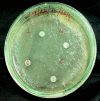Green synthesis and characterization of Ag nanoparticles from Mangifera indica leaves for dental restoration and antibacterial applications
- PMID: 28470622
- PMCID: PMC5433963
- DOI: 10.1007/s40204-017-0067-9
Green synthesis and characterization of Ag nanoparticles from Mangifera indica leaves for dental restoration and antibacterial applications
Abstract
Green synthesis has gained a wide recognition as clean synthesis technique in the recent years. In the present investigation, silver nanoparticles were prepared by a novel green synthesis technique using Mangifera indica (Mango leaves) and found to be successfully used in dental applications. The prepared samples were spectroscopically characterized by XRD, PSA, SEM with EDS, and UV-Vis spectroscopy. The crystalline size and lattice strain were analyzed from the XRD data which were counter-verified by W-H plots and particle size analyzer. The XRD peaks revealed that average crystalline size of the as-synthesized Ag nanoparticles was of 32.4 nm with face-centered cubic structure. This was counter-verified by particle size analyzer and Williamson-Hall plots and found to be 31.7 and 33.21 nm in the former and latter, and the crystalline size of Ag NPs could be concluded as 32 ± 2 nm. The morphological structure of the prepared sample was studied through SEM images and the chemical composition was analyzed by the EDS data. The band energy was calculated as 393 nm from UV-Vis, which confirmed the synthesized sample as Ag nanoparticles. To improve the mechanical bonding and hardness of the dentally used glass ionomer cement (GIC), the synthesized silver nanoparticles were incorporated into GIC in 2% weight ratio. The morphology of the prepared specimens was studied using optical microscope images. Vickers microhardness and Monsanto hardness tests were performed on GIC, GIC reinforced with microsilver particles and GIC reinforced with nanosilver particles and the latter derived a promising results. The results of the Monsanto tests confirmed the increase in hardness of the GIC reinforced with AgNps as 14.2 kg/cm2 compared to conventional GIC and GIC reinforced with silver microparticle as 11.7 and 9.5 kg/cm2. Similarly the Vickers hardness results exhibited the enhanced hardness of GIC-reinforced AgNps as 82 VHN compared to GIC as 54 and GIC-reinforced silver microparticles as 61 VHN. The antibacterial activity of AgNPs was tested by a well-diffusion method on Escherichia coli and Staphylococcus aureus bacteria, and the obtained results exhibited a promising antibacterial activity of the as-synthesized nanoparticles.
Keywords: Antibacterial activity; Ionomer cement; Monsanto hardness; Silver nanoparticles; Vickers hardness.
Conflict of interest statement
Funding information
The present work was funded by All India Institute of Technical Education (AICTE)–GATE meritorious fellowship, Grant No. (1-1889699051).
Conflict of interest
All authors declare that they do not have any financial or any other conflict of interest/s.
Ethical approval
No animals or humans were used in the present work.
Figures











Similar articles
-
Evaluation of the antibacterial activity, surface microhardness, and color change of glass ionomer cement containing green synthesized Ag@MoS2 nanocomposite after thermal aging.Clin Oral Investig. 2025 Jun 25;29(7):354. doi: 10.1007/s00784-025-06437-8. Clin Oral Investig. 2025. PMID: 40560278 Free PMC article.
-
Antimicrobial activity of biosynthesized silver nanoparticles, amoxicillin, and glass-ionomer cement againstStreptococcus mutansandStaphylococcus aureus.Nanotechnology. 2021 Mar 3;32(21). doi: 10.1088/1361-6528/abe577. Nanotechnology. 2021. PMID: 33657016
-
Antimicrobial Efficacy of Glass Ionomer Cement in Incorporation with Biogenic Zingiber officinale Capped Silver-Nanobiotic, Chlorhexidine Diacetate and Lyophilized Miswak.Molecules. 2022 Jan 14;27(2):528. doi: 10.3390/molecules27020528. Molecules. 2022. PMID: 35056835 Free PMC article.
-
The effect of zeolite incorporation on the physical properties of silver-reinforced glass ionomer cement.J Mater Sci Mater Med. 2022 Apr 11;33(4):38. doi: 10.1007/s10856-022-06659-2. J Mater Sci Mater Med. 2022. PMID: 35404019 Free PMC article.
-
Green synthesis, characterization of silver nanoparticals for biomedical application and environmental remediation.J Microbiol Methods. 2022 Feb;193:106384. doi: 10.1016/j.mimet.2021.106384. Epub 2021 Nov 23. J Microbiol Methods. 2022. PMID: 34826520 Review.
Cited by
-
Effects of conventional and herbal irrigants on microhardness and flexural strength of root canal dentin: An in vitro study.J Conserv Dent. 2021 Jan-Feb;24(1):83-87. doi: 10.4103/JCD.JCD_426_20. Epub 2021 Jul 5. J Conserv Dent. 2021. PMID: 34475686 Free PMC article.
-
Incorporation of Nanomaterials in Glass Ionomer Cements-Recent Developments and Future Perspectives: A Narrative Review.Nanomaterials (Basel). 2022 Oct 29;12(21):3827. doi: 10.3390/nano12213827. Nanomaterials (Basel). 2022. PMID: 36364603 Free PMC article. Review.
-
Applications of nano-materials in diverse dentistry regimes.RSC Adv. 2020 Apr 20;10(26):15430-15460. doi: 10.1039/d0ra00762e. eCollection 2020 Apr 16. RSC Adv. 2020. PMID: 35495474 Free PMC article. Review.
-
Biogenic Preparation and Characterization of Silver Nanoparticles from Seed Kernel of Mangifera indica and Their Antibacterial Potential against Shigella spp.Molecules. 2023 Mar 8;28(6):2468. doi: 10.3390/molecules28062468. Molecules. 2023. PMID: 36985439 Free PMC article.
-
Effect of Mangifera Indica (Mango) on Dental Caries: A Systematic Review.Nutr Metab Insights. 2023 Nov 18;16:11786388231204200. doi: 10.1177/11786388231204200. eCollection 2023. Nutr Metab Insights. 2023. PMID: 38024868 Free PMC article. Review.
References
-
- Alan Creighton J, Blatchford CG, Grant Albrecht M. Plasma resonance enhancement of Raman scattering by pyridine adsorbed on silver or gold sol particles of size comparable to the excitation wavelength. J Chem Soc Faraday Trans. 1979;2(75):790–798. doi: 10.1039/f29797500790. - DOI
-
- Bae CH, Nam SH, Park SM. Formation of silver nanoparticles by laser ablation of a silver target in NaCl solution. Appl Surf Sci. 2002;197:628–634. doi: 10.1016/S0169-4332(02)00430-0. - DOI
LinkOut - more resources
Full Text Sources
Other Literature Sources
Research Materials
Miscellaneous

